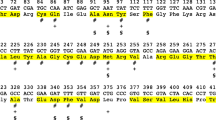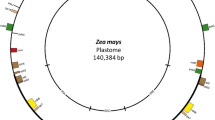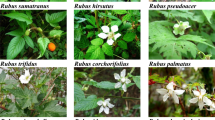Abstract
Molecular evolution of the large subunit of the RuBisCO enzyme is understudied in early diverging land plants. These groups show morphological and eco-physiological adaptations to the uneven and intermittent distribution of water in the terrestrial environment. This might have prompted a continuous fine-tuning of RuBisCO under a selective pressure modifying the species-specific optima for photosynthesis in contrasting microdistributions and environmental niches. To gain a better insight into the molecular evolution of RuBisCO large subunits, the aim of this study was to assess the pattern of evolutionary change in the amino acid residues in a monophyletic group of Bryophyta (Orthotrichaceae). Tests for positive, neutral, or purifying selection at the amino acid level were assessed by comparing rates (ω) of non-synonymous (dN) and synonymous (dS) nucleotide substitutions along a Maximum Likelihood phylogenetic tree. Molecular adaptation tests using likelihood ratio tests, reconstruction of ancestral amino acid sites, and intra-protein coevolution analyses were performed. Variable amino acid sites (39) were unevenly distributed across the LSU. The residues are located on rbcL sites that are highly variable in higher plants and close to key regions implying dimer–dimer (L2L2), RuBisCO-activase interactions, and conformational functions during catalysis. Ten rbcL sites (32, 33, 91, 230, 247, 251, 255, 424, 449 and 475) have been identified by the Bayesian Empirical Bayes inference to be under positive selection and under adaptive evolution under the M8 model. The pattern of amino acid variation suggests that it is not lineage specific, but rather representative of a case of convergent evolution, suggesting recurrent changes that potentially favor the same amino acid substitutions that are likely optimized the RuBisCO activity.


Similar content being viewed by others
References
Albert VA, Backlund A, Bremer K et al (1994) Functional constraints and rbcL evidence for land plant phylogeny. Ann Missouri Bot Gard 81:534–567. https://doi.org/10.2307/2399902
Alpert P, Oechel WC (1987) Comparative patterns of net photosynthesis in an assemblage of mosses with contrasting microdistributions. Am J Bot 74:1787. https://doi.org/10.2307/2443962
Andersson I (2007) Catalysis and regulation in Rubisco. J Exp Bot 59:1555–1568. https://doi.org/10.1093/jxb/ern091
Andersson I, Knight S, Schneider G et al (1989) Crystal structure of the active site of ribulose-bisphosphate carboxylase. Nature 337:229–234. https://doi.org/10.1038/337229a0
Calabrese GM, Muñoz J (2006) Zygodon bistratus sp. nov. (Orthotrichaceae) from the Iberian Peninsula. Bryologist 109:38–42. https://doi.org/10.1639/0007-2745(2006)109[0038:ZBSNOF]2.0.CO;2
Cameron KM, Chase MW, Whitten WM et al (1999) A phylogenetic analysis of the Orchidaceae: evidence from rbcL nucleotide sequences. Am J Bot 86:208–224. https://doi.org/10.2307/2656938
Capella-Gutierrez S, Silla-Martínez JM, Gabaldón T (2009) trimAl: a tool for automated alignment trimming in large-scale phylogenetic analyses. Bioinformatics 25:1972–1973. https://doi.org/10.1093/bioinformatics/btp348
Chase MW, Soltis DE, Olmstead RG et al (1993) Phylogenetics of seed plants: an analysis of nucleotide sequences from the plastid gene rbcL. Ann Missouri Bot Gard 80:528–580. https://doi.org/10.2307/2399846
Codoñer FM, Fares MA (2008) Why should we care about molecular coevolution? Evol Bioinform 4:117693430800400000. https://doi.org/10.1177/117693430800400003
Darriba D, Taboada GL, Doallo R, Posada D (2012) jModelTest 2: more models, new heuristics and parallel computing. Nat Methods 9:772–772. https://doi.org/10.1038/nmeth.2109
de Juan D, Pazos F, Valencia A (2013) Emerging methods in protein co-evolution. Nat Rev Genet 14:249–261. https://doi.org/10.1038/nrg3414
Dunn SD, Wahl LM, Gloor GB (2008) Mutual information without the influence of phylogeny or entropy dramatically improves residue contact prediction. Bioinformatics 24:333–340. https://doi.org/10.1093/bioinformatics/btm604
Erb TJ, Zarzycki J (2018) A short history of RubisCO: the rise and fall (?) of Nature’s predominant CO2 fixing enzyme. Curr Opin Biotechnol 49:100–107. https://doi.org/10.1016/j.copbio.2017.07.017
Erickson DL, Reed E, Ramachandran P et al (2017) Reconstructing a herbivore’s diet using a novel rbcL DNA mini-barcode for plants. AoB Plants 9:plx015. https://doi.org/10.1093/aobpla/plx015
Fares MA, McNally D (2006) CAPS: coevolution analysis using protein sequences. Bioinformatics 22:2821–2822. https://doi.org/10.1093/bioinformatics/btl493
Fares MA, Travers SA (2006) A novel method for detecting intramolecular coevolution: adding a further dimension to selective constraints analyses. Genetics 173:9–23. https://doi.org/10.1534/genetics.105.053249
Galmés J, Andralojc PJ, Kapralov MV et al (2014) Environmentally driven evolution of Rubisco and improved photosynthesis and growth within the C3 genus Limonium (Plumbaginaceae). New Phytol 203:989–999. https://doi.org/10.1111/nph.12858
Garilleti R, Mazimpaka V, Lara F (2015) Ulota larrainii (Orthotrichoideae, Orthotrichaceae, Bryophyta) a new species from Chile, with comments on the worldwide diversification of the genus. Phytotaxa 217:133. https://doi.org/10.11646/phytotaxa.217.2.3
Gastony GJ, Rollo DR (1995) Phylogeny and generic circumscriptions of cheilanthoid ferns (Pteridaceae: Cheilanthoideae) inferred from rbcL nucleotide sequences. Am Fern J 85:341–360. https://doi.org/10.2307/1547814
Glime JM (2007) Physiological ecology. In: Bryophyte ecology, vol 1. Michigan Technological University and the International Association of Bryologists, Houghton
Goffinet B, Vitt DH (1998) Revised generic classification of the Orthotrichaceae based on a molecular phylogeny and comparative morphology. In: Wates JW, Ashton NW, Duckett JG (eds) Bryology for the twenty-first century, 1st edn. British Bryological Society, London, pp 143–159
Goffinet B, Bayer RJ, Vitt DH (1998) Circumscription and phylogeny of the Orthotrichales (Bryopsida) inferred from rbcL sequence analyses. Am J Bot 85:1324–1337. https://doi.org/10.2307/2446642
Goffinet B, Cox CJ, Shaw AJ, Hedderson TAJ (2001) The Bryophyta (mosses): systematic and evolutionary inferences from an rps4 gene (cpDNA) phylogeny. Ann Bot 87:191–208. https://doi.org/10.1006/ANBO.2000.1318
Goffinet B, Shaw AJ, Cox CJ et al (2004) Phylogenetic inferences in the Orthotrichoideae (Orthotrichaceae: Bryophyta) based on variation in four loci from all genomes. Monogr Syst Bot Missouri Bot Gard 98:270–289
Gong L, Olson M, Wendel J (2014) Cytonuclear evolution of Rubisco in four allopolyploid lineages. Mol Biol Evol 31:2624–2636. https://doi.org/10.1093/molbev/msu207
Green TGA, Lange OL (1994) Photosynthesis in poikilohydric plants: a comparison of Lichens and Bryophytes. In: Schulze ED, Caldwell MM (eds) Ecophysiology of photosynthesis. Springer, Berlin, pp 319–341
Group CPW (2009) A DNA barcode for land plants. Proc Natl Acad Sci 106:12794–12797
Guindon S, Dufayard JF, Lefort V et al (2010) New algorithms and methods to estimate maximum-likelihood phylogenies: assessing the performance of PhyML 3.0. Syst Biol 59:307–321. https://doi.org/10.1093/sysbio/syq010
Guo SL, Ma YH, Cao T, Lou YX (2012) A synopsis of Macromitrium (Orthotrichaceae) in China. Cryptogam Bryol 33:341–355. https://doi.org/10.7872/cryb.v33.iss4.2012.341
Hasebe M, Wolf PG, Pryer KM et al (1995) Fern phylogeny based on rbcL nucleotide sequences. Am Fern J 85:134–181. https://doi.org/10.2307/1547807
Hermida-Carrera C, Kapralov MV, Galmés J (2016) Rubisco catalytic properties and temperature response in crops. Plant Physiol 171:2549–2561. https://doi.org/10.1104/pp.16.01846
Hermida-Carrera C, Fares MA, Fernández Á et al (2017) Positively selected amino acid replacements within the RuBisCO enzyme of oak trees are associated with ecological adaptations. PLoS ONE 12:e0183970. https://doi.org/10.1371/journal.pone.0183970
Hermida-Carrera C, Fares MA, Font-Carrascosa M et al (2020) Exploring molecular evolution of Rubisco in C3 and CAM Orchidaceae and Bromeliaceae. BMC Evol Biol 20:1–17. https://doi.org/10.1186/s12862-019-1551-8
Huerta-Cepas J, Serra F, Bork P (2016) ETE 3: reconstruction, analysis, and visualization of phylogenomic data. Mol Biol Evol 33:1635–1638. https://doi.org/10.1093/molbev/msw046
Iida S, Miyagi A, Aoki S et al (2009) Molecular adaptation of rbcL in the heterophyllous aquatic plant Potamogeton. PLoS ONE 4:e4633. https://doi.org/10.1371/journal.pone.0004633
Kannappan B, Gready JE (2008) Redefinition of Rubisco carboxylase reaction reveals origin of water for hydration and new roles for active-aite residues. J Am Chem Soc 130:15063–15080. https://doi.org/10.1021/ja803464a
Kapralov MV, Filatov DA (2006) Molecular adaptation during adaptive radiation in the Hawaiian endemic genus Schiedea. PLoS ONE 1:e8. https://doi.org/10.1371/journal.pone.0000008
Kapralov MV, Filatov DA (2007) Widespread positive selection in the photosynthetic Rubisco enzyme. BMC Evol Biol 7:73. https://doi.org/10.1186/1471-2148-7-73
Kapralov MV, Smith JAC, Filatov DA (2012) Rubisco evolution in C4 eudicots: an analysis of Amaranthaceae sensu lato. PLoS ONE 7:e52974. https://doi.org/10.1371/journal.pone.0052974
Katoh K, Rozewicki J, Yamada KD (2017) MAFFT online service: multiple sequence alignment, interactive sequence choice and visualization. Brief Bioinform 20:bbx108. https://doi.org/10.1093/bib/bbx108
Keck F, Rimet F, Bouchez A, Franc A (2016) phylosignal: an R package to measure, test, and explore the phylogenetic signal. Ecol Evol 6:2774–2780. https://doi.org/10.1002/ece3.2051
Kellogg EA, Juliano ND (1997) The structure and function of RuBisCO and their implications for systematic studies. Am J Bot 84:413–428. https://doi.org/10.2307/2446015
Lara F, Garilleti R, Goffinet B et al (2016) Lewinskya, a new genus to accommodate the phaneroporous and monoicous taxa of Orthotrichum (Bryophyta, Orthotrichaceae). Cryptogam Bryol 37:361–382. https://doi.org/10.7872/cryb/v37.iss4.2016.361
Larson EM, O’Brien CM, Zhu G et al (1997) Specificity for activase is changed by a Pro-89 to Arg substitution in the large subunit of ribulose-1,5-bisphosphate carboxylase/oxygenase. J Biol Chem 272:17033–17037. https://doi.org/10.1074/jbc.272.27.17033
Lewis PO (2001) A likelihood approach to estimating phylogeny from discrete morphological character data. Syst Biol 50:913–925. https://doi.org/10.1080/106351501753462876
Liu L, Zhao B, Zhang Y, Wang J (2012) Adaptive evolution of the rbcL gene in Brassicaceae. Biochem Syst Ecol 44:13–19. https://doi.org/10.1016/j.bse.2012.04.007
Liu Y, Johnson MG, Cox CJ et al (2019) Resolution of the ordinal phylogeny of mosses using targeted exons from organellar and nuclear genomes. Nat Commun 10:1485. https://doi.org/10.1038/s41467-019-09454-w
Maddison WP, Maddison DR (2019) Mesquite: a modular system for evolutionary analysis. Version 3.61 http://www.mesquiteproject.org.
Manhart JR (1994) Phylogenetic analysis of green plant rbcL sequences. Mol Phylogenet Evol 3:114–127. https://doi.org/10.1006/mpev.1994.1014
Massingham T, Goldman N (2005) Detecting amino acid sites under positive selection and purifying selection. Genetics 169:1753–1762. https://doi.org/10.1534/genetics.104.032144
Masuzaki H, Shimamura M, Furuki T et al (2010) Systematic position of the enigmatic liverwort Mizutania (Mizutaniaceae, Marchantiophyta) inferred from molecular phylogenetic analyses. Taxon 59:448–458. https://doi.org/10.1002/tax.592010
Matcham HW, O’Shea BJ (2005) A review of the genus Codonoblepharon Schwgr. (Bryopsida: Orthotrichaceae). J Bryol 27:129–135. https://doi.org/10.1179/037366805X53040
Miwa H, Odrzykoski IJ, Matsui A et al (2009) Adaptive evolution of rbcL in Conocephalum (Hepaticae, Bryophytes). Gene 441:169–175. https://doi.org/10.1016/j.gene.2008.11.020
Mizia P, Myszczyński K, Ślipiko M et al (2019) Comparative plastomes analysis reveals the first infrageneric evolutionary hotspots of Orthotrichum s.l. (Orthotrichaceae, Bryophyta). Turk J Bot 43:444–457. https://doi.org/10.3906/bot-1811-13
Nielsen R, Yang Z (1998) Likelihood models for detecting positively selected amino acid sites and applications to the HIV-1 envelope gene. Genetics 148:929–936. https://doi.org/10.1021/ja803464a
Norris DH, Shevock JR, Goffinet B (2004) Orthotrichum kellmanii (Bryopsida, Orthotrichaceae), a remarkable new species from the central coast of California. Bryologist 107:209–214. https://doi.org/10.1639/0007-2745(2004)107
Ott CM, Smith BD, Portis AR, Spreitzer RJ (2000) Activase region on chloroplast ribulose-1,5-bisphosphate carboxylase/oxygenase: nonconservative substitution in the large subunit alters species specificity of protein interaction. J Biol Chem 275:26241–26244. https://doi.org/10.1074/jbc.M004580200
Pagel M (1999) Inferring the historical patterns of biological evolution. Nature 401:877–884. https://doi.org/10.1038/44766
Pie MR (2006) The influence of phylogenetic uncertainty on the detection of positive Darwinian selection. Mol Biol Evol 23:2274–2278. https://doi.org/10.1093/molbev/msl116
Portis AR (2003) Rubisco activase–Rubisco’s catalytic chaperone. Photosynth Res 75:11–27. https://doi.org/10.1023/A:1022458108678
Portis AR, Li C, Wang D, Salvucci ME (2007) Regulation of Rubisco activase and its interaction with Rubisco. J Exp Bot 59:1597–1604. https://doi.org/10.1093/jxb/erm240
Proctor MCF (1979) Structural and eco-physiological adaptation in Bryophytes. In: Clarke GC, Duckett J (eds) Bryophyte systematics. Academic Press, London, pp 479–509
Revell LJ (2012) phytools: an R package for phylogenetic comparative biology (and other things). Methods Ecol Evol 3:217–223. https://doi.org/10.1111/j.2041-210X.2011.00169.x
Schluter D, Price T, Mooers AØ, Ludwig D (1997) Likelihood of ancestor states in adaptive radiation. Evolution (NY) 51:1699–1711. https://doi.org/10.1111/j.1558-5646.1997.tb05095.x
Sen L, Fares MA, Liang B et al (2011) Molecular evolution of rbcL in three gymnosperm families: identifying adaptive and coevolutionary patterns. Biol Direct 6:29. https://doi.org/10.1186/1745-6150-6-29
Shaw AJ, Devos N, Liu Y et al (2016) Organellar phylogenomics of an emerging model system: Sphagnum (peatmoss). Ann Bot 118:185–196. https://doi.org/10.1093/aob/mcw086
Spreitzer RJ, Salvucci ME (2002) Rubisco: structure, regulatory interactions, and possibilities for a better enzyme. Annu Rev Plant Biol 53:449–475. https://doi.org/10.1146/annurev.arplant.53.100301.135233
Stenøien HK (2008) Slow molecular evolution in 18S rDNA, rbcL and nad5 genes of mosses compared with higher plants. J Evol Biol 21:566–571. https://doi.org/10.1111/j.1420-9101.2007.01479.x
Studer RA, Christin PA, Williams MA, Orengo CA (2014) Stability-activity tradeoffs constrain the adaptive evolution of RubisCO. Proc Natl Acad Sci USA 111:2223–2228
Suchard MA, Lemey P, Baele G et al (2018) Bayesian phylogenetic and phylodynamic data integration using BEAST 1.10. Virus Evol 4:vey016. https://doi.org/10.1093/ve/vey016
Tomescu AMF, Bomfleur B, Bippus AC, Savoretti A (2018) Why are Bryophytes so rare in the fossil record? A spotlight on taphonomy and fossil preservation. In: Krings M, Harper CJ, Cuneo NR, Rothwell GW (eds) Transformative paleobotany, 1st edn. Academic Press, London, pp 375–416
Tsubota H, De Luna E, González D et al (2004) Molecular phylogenetics and ordinal relationships based on analyses of a large-scale data set of 600 rbcL sequences of mosses. Hikobia 14:149–170
Wang M, Kapralov MV, Anisimova M (2011) Coevolution of amino acid residues in the key photosynthetic enzyme Rubisco. BMC Evol Biol 11(1):266. https://doi.org/10.1186/1471-2148-11-266
Waterhouse A, Bertoni M, Bienert S et al (2018) SWISS-MODEL: homology modelling of protein structures and complexes. Nucleic Acids Res 46:W29–W303. https://doi.org/10.1093/nar/gky427
Wong SL, Zhang LV, Tong AHY et al (2004) Combining biological networks to predict genetic interactions. Proc Natl Acad Sci U S A 101:15682–15687. https://doi.org/10.1073/pnas.0406614101
Yang Z (2007) PAML 4: phylogenetic analysis by maximum likelihood. Mol Biol Evol 24:1586–1591. https://doi.org/10.1093/molbev/msm088
Yang Z, Nielsen R, Goldman N, Pedersen A (2000) Codon-substitution models for heterogeneous selection pressure at amino acid sites. Genetics 155:431–449
Yang Z, Wong WSW, Nielsen R (2005) Bayes empirical Bayes inference of amino acid sites under positive selection. Mol Biol Evol 22:1107–1118. https://doi.org/10.1093/molbev/msi097
Yao X, Tan Yh, Jb Y et al (2019) Exceptionally high rates of positive selection on the rbcL gene in the genus Ilex (Aquifoliaceae). BMC Evol Biol 1:192. https://doi.org/10.1186/s12862-019-1521-1
Acknowledgements
We thank the subject editor, two anonymous reviewers, and J. Martínez-Abaigar for providing insightful comments and constructive criticisms that greatly improved the manuscript.
Author information
Authors and Affiliations
Contributions
MB and JAR conceived the study, MB and JAR designed the analysis performance, MB performed the analysis, and MB and JAR wrote the manuscript. All authors read and approved the manuscript.
Corresponding author
Ethics declarations
Conflict of interest
The authors declare that they have no conflict of interest.
Consent for Publication
All authors declare that they have read and approved the manuscript version to be published.
Additional information
Handling editor: Dorothee Huchon.
Supplementary Information
Below is the link to the electronic supplementary material.
Rights and permissions
About this article
Cite this article
Bernabeu, M., Rosselló, J.A. Molecular Evolution of rbcL in Orthotrichales (Bryophyta): Site Variation, Adaptive Evolution, and Coevolutionary Patterns of Amino Acid Replacements. J Mol Evol 89, 225–237 (2021). https://doi.org/10.1007/s00239-021-09998-w
Received:
Accepted:
Published:
Issue Date:
DOI: https://doi.org/10.1007/s00239-021-09998-w




